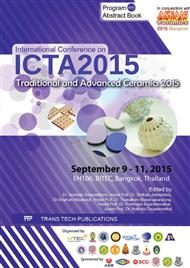p.39
p.45
p.51
p.57
p.65
p.71
p.76
p.81
p.87
The Effect of Alumina (Al2O3) on the Characteristics of Sintered Mullite-Cordierite Ceramics Synthesized with Kaolin from Naratiwas of Thailand
Abstract:
Mullite-cordierite ceramics was prepared by the three composition of talc, kaolin (kaolin from Naratiwas in Thailand) (NT) and alumina. The different amounts of alumina (5, 10, 15 and 20 wt%) were added to produce various mullite-cordierite alumina mixtures which are denoted as NA, NB, NC and ND, respectively. The mixtures were pressed into rectangular shapes by hydraulic press with the pressure of 150 kg/cm2 then sintered at temperature of 1300 °C and 1350 °C for 2 hours. The morphology of the synthesized mullite-cordierite samples were characterized by x-ray diffraction spectroscopy (XRD), and physical-mechanical properties were investigated. Mullite-cordierite was successfully synthesized. The XRD result was represented phases of mullite and cordierite. The NA samples sintered at temperature of 1300 °C indicated the best physical-mechanical properties including bulk density (2.23 g/cm3), flexural strength (44.4 MPa) and thermal expansion coefficients (5.00x10-6). The other NA samples sintered at temperature of 1350 °C exhibited the bulk density, flexural strength and thermal expansion coefficients are 2.21 g/cm3, 47.8 MPa and 4.99 x10-6, respectively. The thermal expansion coefficient of the NT sintered samples have been plotted the length change relative to measuring temperature ranging of 30-1200 °C. The suitable condition of the synthesized mullite-cordierite ceramics is finally obtained the NA samples with 5 percent weight of alumina composition sintered at the temperature of 1350 °C.
Info:
Periodical:
Pages:
65-70
Citation:
Online since:
May 2016
Authors:
Keywords:
Price:
Сopyright:
© 2016 Trans Tech Publications Ltd. All Rights Reserved
Share:
Citation:


